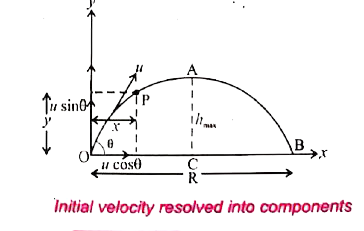Derive the equation of motion, range and maximum height reached by the particle thrown at an oblique angle θ with respect to the horizontal direction. Solution in Tamil
Let us consider an object thrown with initial velocity →u an angle θ with the horizontal as in figure
→u=uzˆi+uyˆj
The horizontal component of velocity ux=ucosθ . The vertical component of velocity uy=usinθ .
Since the acceleration due to gravity is in the direction opposite to the direction of vertical component uy this component will gradually reduce to zero at the maximum height of the projectile. At this maximum height, the same gravitational force will push the projectile to move downward . It falls to the ground. there isno acceleration along the x direction throughout the motion. Hence, the horizontal component of the velocity (ux=ucosθ) remains the same till the object reaches the ground .
Hence after the time t , the velocity along horizontal motion vx=ux+axt [ ∵ux=ucosθ ]
The horizontal distance travelled by projectile in time t is sx=uxt+12axt2
Here, sx=x,ux=ucosθ,ax=0
Thus , x =ucosθtort=xucosθ ...(1)
For the vertical motion vy=uy+ayt
Here uy=usinθ,ay=−g (acceleration due to gravity acts opposite to the motion) . Thus
vy=usinθ−gt ...(2)
the vertical distance travelled by the projectile in the same time t is
sy=uyt+12ayt2
Here , sy=y,uy=usinθ,ax=−g. Then
y=usinθt−12gt2 ...(3)
Substitute the value of t from equation (1) in equation (3) , we have
y=usinθxucosθ−12g(x2)u2cos2θ
y=xtanθ−12g(x2)u2cos2θ ...(4)
Thus the path followed by the projectile is an inverted parabola.
Maximum height (hmax) :
The maximum vertical distance travelled by the projectile during its journey is called maximum height
For the vertical part of the motion,
v2y=u2y+2ays
Here, uy=usinθ,a=−g,s=hmax , and at t he maximum height vy=0
∴(0)=u2sin2θ=2ghmax
or hmax=u2sin2θ2g
Horinontal range (R) : The maximum horizontal distance between the point of projection and the point on the horizontal plane where the projectile hits the ground is called horizontal range (R) . It is found easily. Since the horizontal component of initial velocity remains the same.We can write Range R={Horizontal componentof velocity×time of flight
=ucosθ×Tf
R=ucosθ×2usinθg
=2u2sinθcosθg
⇒∴R=u2sin2θg

Topper's Solved these Questions
- KINEMATICS BOOK - PREMIERS PUBLISHERSCHAPTER - KINEMATICS EXERCISE - Textbook questions & answers (IV. Numerical problems).
48 Videos
- KINEMATICS BOOK - PREMIERS PUBLISHERSCHAPTER - KINEMATICS EXERCISE - Other important questions & answers (I.Multiple choice questions).
236 Videos
- KINEMATICS BOOK - PREMIERS PUBLISHERSCHAPTER - KINEMATICS EXERCISE - Textbook questions & answers (II. Short answer questions).
30 Videos
- GRAVITATIONBOOK - PREMIERS PUBLISHERSCHAPTER - GRAVITATIONEXERCISE - OTHER IMPORTANT QUESTION & ANSWERS (CONCEPTUAL QUESTIONS)
34 Videos
- KINETIC THEORY OF GASESBOOK - PREMIERS PUBLISHERSCHAPTER - KINETIC THEORY OF GASESEXERCISE - OTHER IMPORTANT QUESTIONS & ANSWERS (VI. Conceptual Questions.)
8 Videos
Similar Questions
The position vectors particle has length 1m and makes 30∘ with the x-axis. What are the lengths of the x and y components of the position vector?
View SolutionKinematics is the branch of mechanics which delas with the motion of objects without taking _________ into account
View SolutionWhat is meant by Cartesian coordinate system?
View SolutionWhy a body weighs less at the equator than at the poles?
View SolutionWhen an automobile travels for a long distance , the air pressure in the tyres increases slightly . Why ?
View SolutionA projectile is thrown at an angle of theta=45^(@) to the horizontal, reaches maximum reaches a maxium height of 16m , then
View SolutionA ball is thrown at an angle theta with the horizontal and the range is maximum. The value of tantheta is:-
View SolutionDerive the equation of motion, range and maximum height reached by the particle thrown at an oblique angle θ with respect to the horizontal direction.
View SolutionAn object is thrown with initial speed 5ms^(-1) with an angle of projection 30^(@) . What is the maximum height and range reached by the particle?
View SolutionA particle when thrown obliquely from ground, can have a maximum horizontal range 'X'. When it is thrown vertically upwards with the same speed, the maximum height reached by the particle, will be 2 Х 2x √2
View Solution[" A particle when thrown obliquely from ground,"],[" can have a maximum horizontal range "'x'" .When "],[" it is thrown vertically upwards with the same "],[" speed,the maximum height reached by the "],[" particle,will be "],[0(x)/(2)]
View SolutionThe maximum height attained by a projectile when thrown at an angle θ with the horizontal is found to be half the horizontal range. Then θ is equal to
View SolutionThe maximum height attained by a projectile when thrown at an angle theta with the horizontal is found to be half the horizontal range. Then theta is equal to
View SolutionDerive the equation of motion, range and maximum height reached by the particle thrown at an oblique angle θ with respect to the horizontal direction.
View SolutionFind the equation of trajectory, time of flight , maximum height and horizontal range of a projectile when projected at an angle theta with the vertical direction .
View Solution
